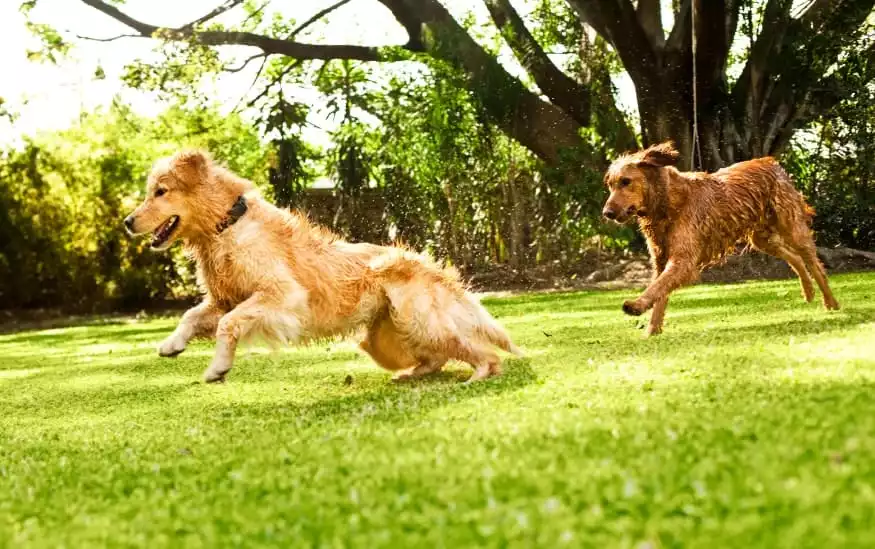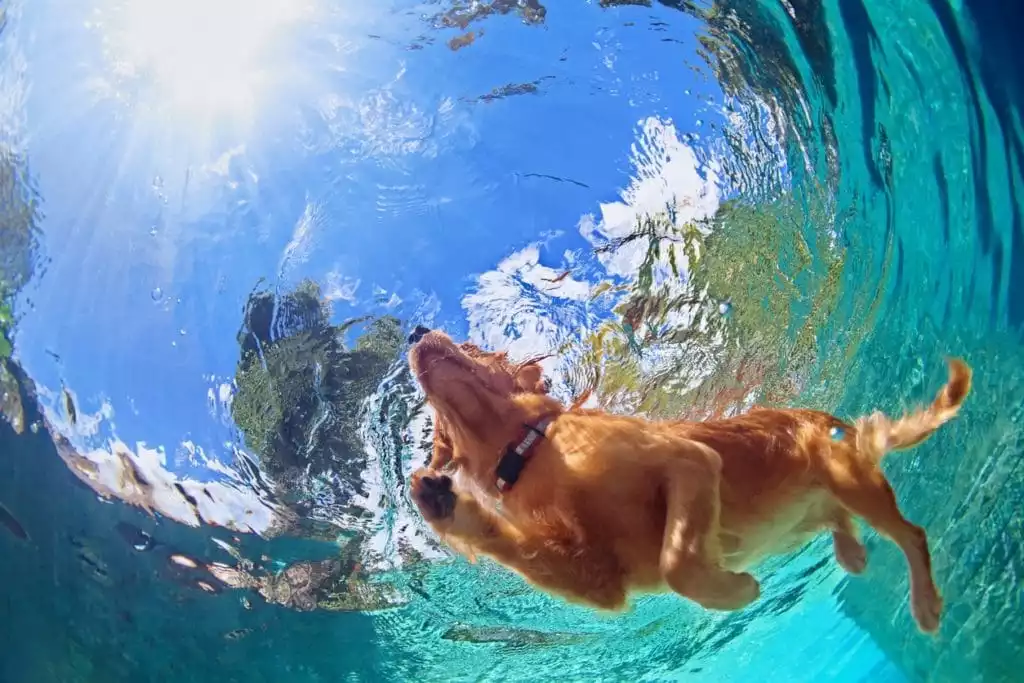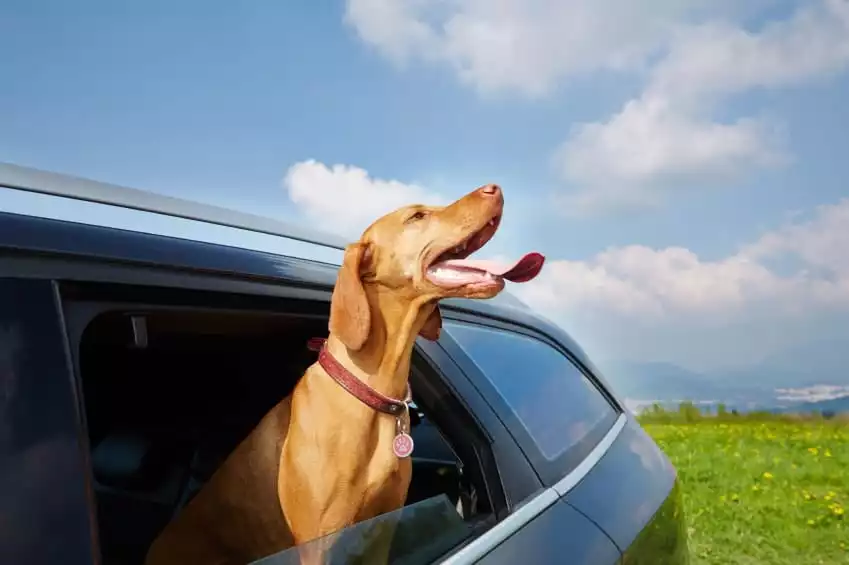
The summer months are heating up, and while your pets may love being with you at all times, it’s important to keep their safety in mind with these summer pet safety tips.
Our pets don’t have the freedom (or thumbs) to adjust the thermostat, or grab a glass of water, so it’s important for us to take special care in making sure they are comfortable during the summer months.
What Are Common Summer Pet Safety Tips to Think About?
Everyone enjoys the summer months – warm weather, more sunlight, and lots of play time.
However, as the summer months approach, it’s important to consider summer pet safety as well.
Some of the most important safety considerations include:
- Heat Illness
- Swimming Tips
- Sun Protection
- Importance of Leashes
- Paw Protection
- Dangerous Outdoor Areas
- Antifreeze Protection
- Hair Cut Tips
- Hot Cars
This summer, consider these summer pet safety tips to keep your furry friends happy, safe, and healthy.
1. Know the Signs of Heat Illness
One of the most important considerations to summer pet safety is knowing the signs of overheating.
Make sure you are familiar with the signs of heat illness in your pets.
You shouldn’t see your pets excessively panting or having trouble breathing. Panting is normal immediately during or after play, but should subside almost immediately.
Excessive drooling, a high respiratory rate, weakness and fatigue, and lethargy are symptoms of an urgent problem.
Sometimes, heat-related illnesses manifest in unusual ways.
Your pets should not have bloody diarrhea or be vomiting, especially after time at the beach or in the sun.
If they do, it’s a sign your pet needs immediate care.
A Note on Brachycephalic Breeds
Do you have animals with flat faces? These breeds, such as Persian cats and Pugs, actually have a harder time panting and are more likely to develop heat illness.
Make sure you are keeping them in cool rooms to avoid issues, or at least provide them with shade and ample ability to escape the heat.
2. Swimming Fun
Ok, so this one is for the dogs. While a lot of dogs love water, they’re not all amazing swimmers, so this needs to be another consideration when it comes to summer pet safety.
Take your time introducing your dog to the water. Rinse your dog off after any type of swimming, especially in chlorinated water and salt water pools. Pool chemicals are not good for your dog, so don’t let them drink the water.
Never leave your dog unsupervised in the water. You’ll want to pay special attention to rip tides and currents.
Even strong swimmers can be quickly carried out to sea or downstream very quickly on a bad day in the water.
Lakes can also have sinkholes and a dog may panic if he suddenly can’t feel his feet touching the bottom.
If you’re heading off to one of our wonderful national parks, or just hitting up the local lake, be aware that there can be unique dangerous present.
Avoid lakes that have blue-green algae or that smell funny, as this type of water can be more toxic if ingested.
Always use canine and human life vests if you are on a boat or swimming longer distances.
If you have a backyard with enough space, giving your dog his own hard plastic kiddie pool will ensure he has a safe place to splash and cool off. Just make sure you put it in the shade.
Be especially mindful if you take your dog swimming in a body of salt water, as the salt can act as a laxative.
You may want to give your pup about a half hour of time on dry land to make sure he isn’t having any GI issues before getting back into the car.
3. Sun Protection
Skin cancer is just as common in dogs and cats as it is in humans.
As a matter of fact, Prevention noted that skin cancer is the most common form in dogs and the second most common in cats.
Summer and hot weather increases the risk of a sunburn, which in turn raises the risk of melanoma.
While your pet’s hair is likely to protect him, pet-friendly sunblocks should be applied to their bellies, to the areas around the ears, and to the areas around the eyes.
This is especially important if you plan on being outside for an extended period of time.
4. Always Use a Leash
This summer, you should also be mindful of using a leash to keep your pets safe outdoors.
Accidents happen, no matter how well trained your pet is. Always have your dog on a leash in public. It’s law in most places, anyway.
New people, other pets, and sudden sounds can send a dog into a panic, causing an unintentional attack on someone nearby or running into traffic or a crowd.
You will also be better able to control and move your dog out of harm’s way if you come into contact with another pet or wild animal that is in distress.
5. Paw Protection
Paw protection is another important aspect of summer pet safety.
Asphalt and concrete surfaces can become very hot on sunny days and your pet’s paws do not offer any sort of protection.
Hot surfaces can cause burns and can also cause your pet’s body temperature to rise faster.
Use caution when approaching any questionable surface.
The metal bed of a truck can burn your dog, too. If you wouldn’t put your bare feet on a surface, don’t make your pets do so.
Keep in mind that if your pets paws do get burned, your pharmacist can create compounded pet medication to relieve the pain. But, it’s better to consider these summer pet safety tips before it comes to that!
6. Not All Open Spaces are Safe
A huge field of grass may look like a great place to pull over, stretch your legs, and let your pet run around.
The truth is that a lot of property owners treat their lawns with pesticides and fertilizers during the summer months.
There is also the chance of coming across fleas or ticks when running through unknown areas. This concern can be reduced with flea and tick medicine, but it’s an important consideration.
It’s safer to take your pet to areas that are known to be pet-friendly and safe, like a dog-friendly beach, walking trail, or dog park.
7. Avoid Antifreeze
The antifreeze you put into your car is apparently quite appetizing to pets.
It’s also incredibly poisonous to both dogs and cats alike, even in very small amounts.
While this is a year-round concern, people are more likely to have issues and leaks during the summer months.
Make sure you are keeping your pets away from puddles in driveways and parking lots as you explore the neighborhood.
8. Don’t Cut Your Pet’s Hair
Another consideration for summer pet safety is knowing their type of hair – and what their grooming should include. It may seem logical to cut your pet’s long hair to keep him cooler in the summer, but that’s not exactly true, especially for double-coated breeds.
No matter what your pet’s natural length, the hair does it’s own job circulating and regulating body temperature.
Keeping your pet’s hair brushed so that it doesn’t matt is more important than cutting.
That being said, some dogs do seem more comfortable with a trim or even a shave, especially if they’re older, infirm, or have trouble grooming themselves.
See your vet or a groomer for one-on-one advice.
9. NEVER Leave Your Dog in the Car
The number one rule of summer pet safety is this: never, ever leave your dog unattended in a car.
The temperature inside a closed car rises very rapidly and your pet can become overheated and suffocate in mere minutes.
On a comfortable 78 degree day, your car’s temperature can rise to up to 160 degrees if parked directly in the sun.
Always carry water with you when traveling with your pet; and leave him at home if you won’t be able to take him with you when you leave the car.
Summer fun means taking the entire family along – including your pets. But just as you would consider your children’s safety in the summer, you should do the same for summer pet safety.
Make sure you are mindful of their health and safety needs and are keeping them as safe as possible with these summer pet safety tips.
They’ll love you for including them in “pack” activities!

 info@burtsrx.com
info@burtsrx.com


